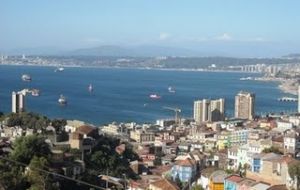MercoPress. South Atlantic News Agency
Exhibits commemorate Chile’s immigrants from eight communities
 The cultural diversity that settled in the port of Valparaíso
The cultural diversity that settled in the port of Valparaíso Chileans of German, British, Italian, Spanish, Japanese, French, Arab and Israeli descent sacrificed part of their heritage in the late 19th and early 20th centuries upon immigrating to Chile. Though their history is oft-forgotten in modern-day Chile, new exhibitions on display in Santiago and Valparaíso this month will show more than 70 photographs and 50 personal items representing the immigrant experience.
In Valparaíso, an exhibition titled “Identity Map” will take place at the Extension Centre of Identity and Heritage in Plaza Sotomayor. According to Christian Baez, manager and curator of the multiculturalism program of the Council of Culture, this is the first time that eight foreign communities come together to commemorate their families’ arrival in Chile through the port of Valparaiso.
“It is an intimate sample that reflects the cultural diversity that settled in the port,” Baez told La Tercera. “The Spanish gave us blankets and castanets, the Japanese gave us kimonos, and the Arabs gave us bottles where the women kept their makeup. We even have passports of Jewish immigrants from Nazi Germany.”
The photos, ranging from 1880 to 1940, reflect the immigrants’ family and public life at the time. The images document their arrival in Valparaiso by boat, various sports and judo championships and the commercial side of immigration in those early days where French immigrants owned clothing stores, Italians dominated the grocery business and Arabs ran bazaars and jewellery factories.
In Santiago, an exhibition titled “Portrait of Study” (Valparaiso 1850-1950) will be on display until the end of May in the Biblioteca de Santiago. Organized by the National Photographic Heritage Centre, the exhibition shows 20 portraits of women, men and children in their finest clothes that came forward to the studio to capture memories of their marriages, baptisms and first communions.
“The photo studio was one of the most protracted and daily practices. Everyone wanted to enshrine those unique moments,” said Samuel Salgado, director of Cenfoto.
“At first, only the elite had access to photography, but then it was democratized. This exhibition provides an account of this development, with the main focus being Valparaiso.”
By 1880, Valparaíso was considered the jewel of the Pacific. As the main port of entry to the Americas, the city became the country's economic capital, receiving a large number of immigrants attracted to the rising importance of nitrates in the country.
By Kendra Ablaza – The Santiago Times




Top Comments
Disclaimer & comment rulesCommenting for this story is now closed.
If you have a Facebook account, become a fan and comment on our Facebook Page!